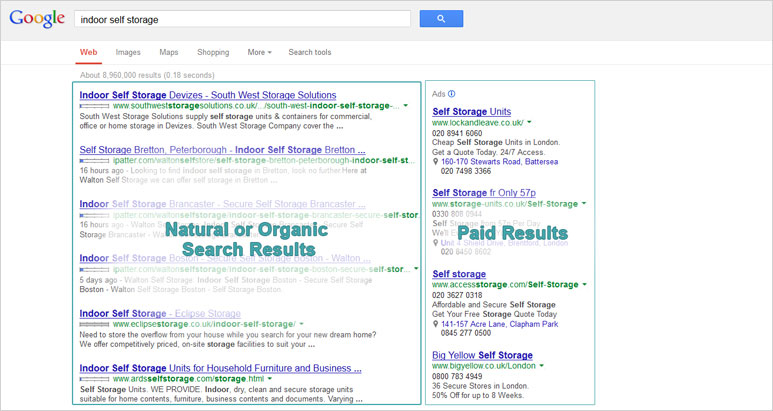

Beginners Guide to SEO
![]() by Paul
by Paul
This seo blog is written for the small business owner, but will be useful for any one looking for a simple explanation of Search Engine Optimisation, how a Search Engine Works, and how to get your website listed and moving up the Search Engine rankings. The information in this seo blog deals only with the “Natural Search Results” often referred to as “Organic Search Results”. It has no relevance for Pay Per Click or Sponsored listings.
Below shows an example of 'Natural Search Results' versus 'Paid Pay per Click Results.

What does a Search Engine do?
A search engine finds the most relevant results from its database, in response to a user's search.
Here is a simple breakdown of what search engines do all day.
Spidering
This is the term used to describe the research phase of a search engine's cycle. It visits your website and reads some or all of the pages. Based on the information it gathers, your website will be grouped with similar sites in its data base. So if your website is about gardens, it will be stored with all the other websites about gardens.
Calculating Page Rank
When the search engine has your website indexed, (in the data base) it assigns level of importance to the pages within the site and the site as a whole. Google calls this Page Rank. Other search engines have different names for this measurement. The more reputable the search engine deems your website, the higher the Page Rank.
Search Results
When a user starts a search in the engine, it will consult its data base to find the best result. It looks at relevance of the words on your pages, and the Page Rank to find the best matched results from the most reputable web sites.These results appear in the “natural” results in the search engines results page. (As opposed to the Sponsored results.)
How to improve your rankings
Here is one simple method that will produce results. It has been constructed with the small business owner in mind, so it cuts a lot of corners, and saves a lot of time. Most importantly it will give you a genuine understanding of Basic Search Engine Optimisation.
This simple list of tasks will improve your rankings, and drive quality, targeted traffic to your website through the major search engines. For these exercises we assume you are using Google.
- Choose your key words and key phrases
- Optimise your website for the chosen keywords and key phrases
- Increase your link popularity
- Measure your results regularly
- Learn from the results and start again at 1.
Choose your Key words and Key phrases
Research your competition
Step 1: Choose a few obvious keywords that directly relate to your industry. For example, if you are an accountant, try “accountant” and “tax planning”.
Step 2: Find a website that ranks well, and is in direct competition with you, or at least offers the same service or product. Ideally, this website is also in the “sponsored listings” on the right side of the Google results page. (Websites that are actively advertising in Pay Per Click Sponsored results are usually well optimised)
Step 3: Visit your competitors website, and right click on any text area. (Not an image, it won't work). Select “View Source”. This will open a new window of code.
Step 4: Near the top of this “code window” there are two lines to look for. One that starts with: title and ends in /title, and another which is usually there but not always, that starts with: "meta name="description". This is is where your competitor's important keywords are hidden.
Optimise your website the basics
Approach one key phrase at a time. Optimise one web page per key phrase.
Step 1
Write an article, or re-write a page of content on your website with your chosen key phrase in mind.
Start with your heading. This should be, or at least include your key phrase. Write approximately 250 words, (minimum) including the key phrase between 5 and 7 times throughout.
Try to get the key phrase twice inside the first 25 words of the text, (not including the heading). If possible, create some sub headings that also include the key phrase.
Step 2
Write a Title and Description for your web page. The Title should be 5 – 7 words, including the key phrase. The description should be around 15 words, including the key phrase. Keep in mind that the description often appears in the search results, so it's needs a bit of “sizzle”.
Step 3
This step requires website editing ability. We recommend using a web developer to assist you, but by preparing the content well, this should be a relatively inexpensive exercise. Insert the optimised text, title and description into the code of your website. Use h1, h2 and p for the content areas. Create Alt tags for all images on the page using your key phrase. Modify the URL of your page to incorporate the key phrase.
Summary
Ideally the entire process of optimisation should be performed on every page of your website, and for all relevant terms for your business. At first you will find that progress up through the search engine results is relatively easy, but as you get closer to the top, it will get harder and harder.
Maintaining good rankings is a matter of constantly monitoring and adjusting.
Here is a quick recap of the basic process.
- Choose your key words and key phrases – Start with competitors' websites, and refine the list using your own judgement
- Optimise your website for the chosen keywords and key phrases – Write original content, and use the correct html tags
- Measure your results regularly
- Learn from the results and start again at 1.Good luck, and let me know how you go!
Need SEO for your business? Check out our seo packages
About Dsgn One
Dsgn One have been building and designing custom websites for organisations in Bath & London for over 6 years. Our friendly, highly experienced team of web designers are here to help you.
View web design packages




